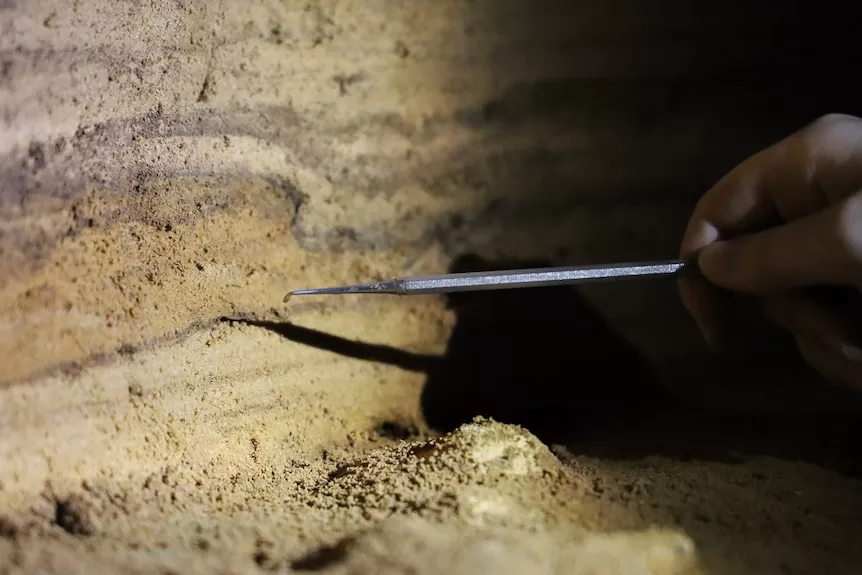- In short: A new study has found ice ages in Australia were wetter than initially thought making it a kinder environment for humans and animals.
- The study took place in the UNESCO World Heritage-listed Naracoorte Caves in South Australia.
- What’s next? The new information paints Australia’s climate past, and its future, in a different light.
In a system of caves on South Australia’s Limestone Coast, researchers have uncovered new information about the coldest times in the continent’s history.
A new study from the University of Melbourne and the University of Adelaide used rock sediments from the Naracoorte Caves to give a snapshot of Australia’s climate over 350,000 years.
Historically, the globe’s climate has slowly fluctuated between cold glacial periods, or ice ages, and warmer interglacial periods, which the earth is in now.
In the Northern Hemisphere, these glacial periods were bitterly cold and brought very little rain, meaning humans and animals would hunker down to avoid the elements and to be close to reliable food sources.
In Australia though, the study found glacial periods were wetter than first thought, meaning the environment was more hospitable for people and animals.
Researchers studied the amount of rainwater found in mineral deposits such as stalagmites and stalactites in the Naracoorte Caves to understand the climate in which they were created.
Uranium dating allowed researchers to find how old the mineral deposits were, with the amount of rainwater inside giving an insight into how wet the climate was during formation.
Lead author Kale Sniderman said this meant flora and fauna were able to continue their spread around the continent during ice ages.
“Researchers have tended to fit their findings into a framework of ecological refuges during what they think is a widespread, very inhospitable landscape,” Dr Sniderman said.
“They say: ‘This animal or plant needed moisture to survive, so how did it survive in an arid landscape? It must’ve survived in tiny little pockets, like deep valleys where moisture was retained.’
“But if that landscape wasn’t really hostile, that inhospitability is a kind of misinterpretation.”
The discovery has painted up to 350,000 years of Australian climate history in a new light.
Dr Sniderman said it would also change how climate experts looked at Australia’s future, particularly in regards to climate change.
“Within the full cycle of temperatures experienced in these regions over hundreds of thousands of years, the warmest times are relatively dry,” he said.
“In broad terms, this implies in the future as the world gets warmer because of human actions of putting extra carbon dioxide into the atmosphere, it’s going to get drier still.”
‘Underground libraries’
The Naracoorte Caves were formed over millions of years.
Made from the limestone that gives the Limestone Coast its name, the area was underwater about 200 million years ago, and once again about 20 million years ago.
That water carved out 26 caves, of which four are open for public tours.
The rest are closed to allow researchers to work without disruption, or because they are too sensitive and should not be disturbed.
“We have an embarrassment of riches in Australia as far as caves go and you can think about them as underground libraries of history,” Adelaide University palaeontologist Liz Reed said.
“Science is the language we use to read those libraries,” Dr Reed said.
The caves are also known for their significant deposits of animal fossils, including megafauna such as the short-nosed kangaroo and the marsupial lion.
Dr Reed said linking climate research with fossil studies would give a clear picture of life in the region thousands of years ago.
“What we hope to do with our research is take our long-term climate records and then see what plants and animals were doing,” she said.
“That adds another layer because we’re seeing responses from flora and fauna to the changes in the environment.
“That can help us understand, from a conservation point of view, where animals are going in the future.”
Rome, Stonehenge, Naracoorte
Manager of the Naracoorte Caves as well as the nearby Tantanoola Caves, Thomas Short said that the caves were an impressive natural formation.
“Once you go into a lot of the research that’s happened inside these caves you start to realise how exceptional these caves are,” he said.
“You see how valuable they are, not only for those aesthetic purposes, it looks really nice, but also from the fact we’ve been able to learn so much about Australia’s natural history.
“It’s a real privilege to be able to work here and pass that knowledge on to the public.”
The caves are a UNESCO World Heritage site, alongside Stonehenge in the UK, the historic centre of Rome, and thousands of other globally significant places.
Mr Short said it was his team’s job to teach everyone the importance of the area.
“It’s not often you’d think of Naracoorte being in the same category as something like the Great Barrier Reef or many of those amazing buildings you might find through Europe,” he said.
“The caves here are up with those places.”
Get our local newsletter, delivered free each Friday
